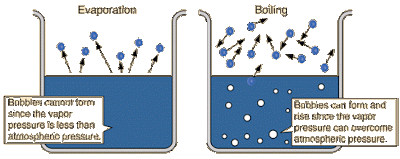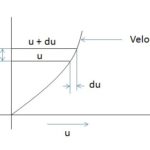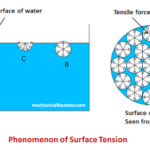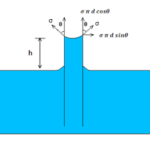Cavitation is a phenomenon of formation of vapor bubbles of
a flowing liquid in a region where the pressure of the liquid becomes equal or
less than the vapor pressure. When these vapor bubbles reaches into the region
of higher pressure, they collapse and creates high impact pressure. These high
impact pressure created by the vapor bubbles eroded the materials from metallic
surface and produces cavity.
a flowing liquid in a region where the pressure of the liquid becomes equal or
less than the vapor pressure. When these vapor bubbles reaches into the region
of higher pressure, they collapse and creates high impact pressure. These high
impact pressure created by the vapor bubbles eroded the materials from metallic
surface and produces cavity.
For better explanation of the above cavitation phenomenon
one must have knowledge of vaporization and vapor pressure.
one must have knowledge of vaporization and vapor pressure.
Also Read: What is Viscosity in Fluid Mechanics?
What is Vaporization?
The change of liquid phase into gaseous phase is called
vaporization. The vaporization depends upon the prevailing temperature and
pressure condition. It occurs due to the continuous escaping of the liquid
molecules from free surface of the liquid.
vaporization. The vaporization depends upon the prevailing temperature and
pressure condition. It occurs due to the continuous escaping of the liquid
molecules from free surface of the liquid.
What is Vapor Pressure?
In order to understand vapor pressure, let’s take a closed
vessel in which a liquid (say water) is present. Let the temperature of the
water is 20 oC and pressure is atmospheric. In this situation the
vaporization of water takes place at 100 oC. As the vaporization of
water starts, the molecules of liquid (vapor) start escaping out from the free
surface of the liquid. The vapor molecules escaping out from the liquid free
surface gets collected between the free surface of the liquid and top of the
vessel. These vapor molecules exerts pressure on the free surface of liquid.
This pressure exerted by the vapor is called vapor pressure. Vapor pressure is
also defined as the pressure at which the liquid changes into vapor
vessel in which a liquid (say water) is present. Let the temperature of the
water is 20 oC and pressure is atmospheric. In this situation the
vaporization of water takes place at 100 oC. As the vaporization of
water starts, the molecules of liquid (vapor) start escaping out from the free
surface of the liquid. The vapor molecules escaping out from the liquid free
surface gets collected between the free surface of the liquid and top of the
vessel. These vapor molecules exerts pressure on the free surface of liquid.
This pressure exerted by the vapor is called vapor pressure. Vapor pressure is
also defined as the pressure at which the liquid changes into vapor
Now, again take a closed vessel filled with a liquid (say water).
Let the temperature of the water is 20 oC and the pressure in the
vessel is reduced by some external source. When the pressure is reduced, the
vaporization temperature is also reduced. Let the pressure inside the vessel is
reduced to such an extent that it becomes equal or less than the vapor
pressure. In this situation the boiling of water takes place even though the
temperature of liquid is 20 oC. Thus the boiling of water takes
place even at ordinary temperature; if the pressure is reduced as such it
becomes equal to or less than the vapor pressure.
Let the temperature of the water is 20 oC and the pressure in the
vessel is reduced by some external source. When the pressure is reduced, the
vaporization temperature is also reduced. Let the pressure inside the vessel is
reduced to such an extent that it becomes equal or less than the vapor
pressure. In this situation the boiling of water takes place even though the
temperature of liquid is 20 oC. Thus the boiling of water takes
place even at ordinary temperature; if the pressure is reduced as such it
becomes equal to or less than the vapor pressure.
Also Read: Types of Fluids In Fluid Mechanics
Explanation of Cavitation
Considered a system in which a liquid (say water) is
flowing. When the flowing water enters into a region where the pressure becomes
equal to or less than that of the vapor pressure. Than the vaporization of
water starts and vapor bubbles are formed in the water. When these vapor
bubbles are carried by the flowing liquid in the region of higher pressure they
explode. The explosion of vapor bubbles creates impact pressure of high intensity.
Since the liquid flows over the metallic surface, the high pressure produced by
explosion of vapor bubbles erodes the material from the metallic surface and
creates cavity. This phenomenon is called cavitation. The bursting of the vapor
bubbles creates noise and vibration.
flowing. When the flowing water enters into a region where the pressure becomes
equal to or less than that of the vapor pressure. Than the vaporization of
water starts and vapor bubbles are formed in the water. When these vapor
bubbles are carried by the flowing liquid in the region of higher pressure they
explode. The explosion of vapor bubbles creates impact pressure of high intensity.
Since the liquid flows over the metallic surface, the high pressure produced by
explosion of vapor bubbles erodes the material from the metallic surface and
creates cavity. This phenomenon is called cavitation. The bursting of the vapor
bubbles creates noise and vibration.
For better explanation watch the video given below:
Cause
Cavitation occurs when pressure of flowing liquid in any
region becomes equal to or less than the vapor pressure.
region becomes equal to or less than the vapor pressure.
Effect
- It results in damage to the metallic surfaces and creates
cavity. - Creates noise and vibration due to sudden collapsing of
vapor bubbles. - It reduces the efficiency of hydraulic machines like turbine
and pumps.
Precaution
- The pressure of the liquid in any part of the hydraulic
system should not be reduced below its vapor pressure. - The special materials or coating such as stainless steel and
aluminium bronze, which are cavitation resistance should be used.
If you like this article than don’t forget to share it on Facebook and Google+.










